West Sulawesi is home to many species of birds, from small, vibrant songbirds to large, majestic raptors. The province is home to more than 200 species of birds, many of which can be found in the protected areas of the province.
These birds are a major part of the province’s rich biodiversity and can be found in a variety of habitats, including forests, rice paddies, and along beaches.
Birds can also be found in the many national parks in the province, including the Lore Lindu National Park, the Tanjung Tinggi National Park, and the Rawa Aopa Watumohai National Park.
Birdwatchers will have plenty of opportunities to observe the various species of birds in the area, from the local Sulawesi endemic species to migrating species from other parts of the world.
1. White-Faced Cuckoo-Dove
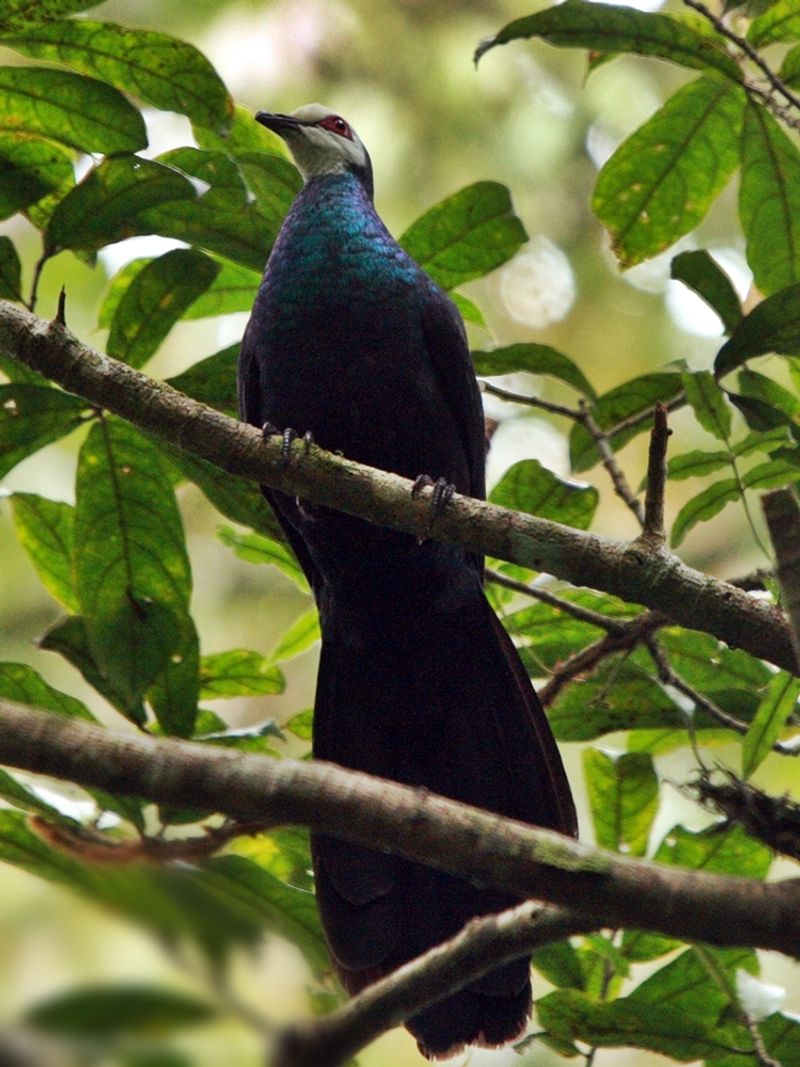
The white-faced cuckoo-dove is a species of bird found in Indonesia, specifically in Sulawesi and the Togian Islands. This species is part of the Columbidae family, which includes other types of doves and pigeons.
The white-faced dove was previously classified as a distinct species but has since been reclassified as belonging to the same species of cuckoo-dove.
This means that it is now considered to be the same species as other cuckoo-doves from the same family, and is given the same scientific name.
The Sula cuckoo-dove, which is found in the same region, was formerly considered to be the same species as the white-faced cuckoo-dove but is now recognized as a distinct species.
| Kingdom | Animalia |
| Phylum | Chordata |
| Class | Aves |
| Order | Columbiformes |
| Family | Columbidae |
| Genus | Turacoena |
| Species | T. manadensis |
2. Yellow-Billed Malkoha
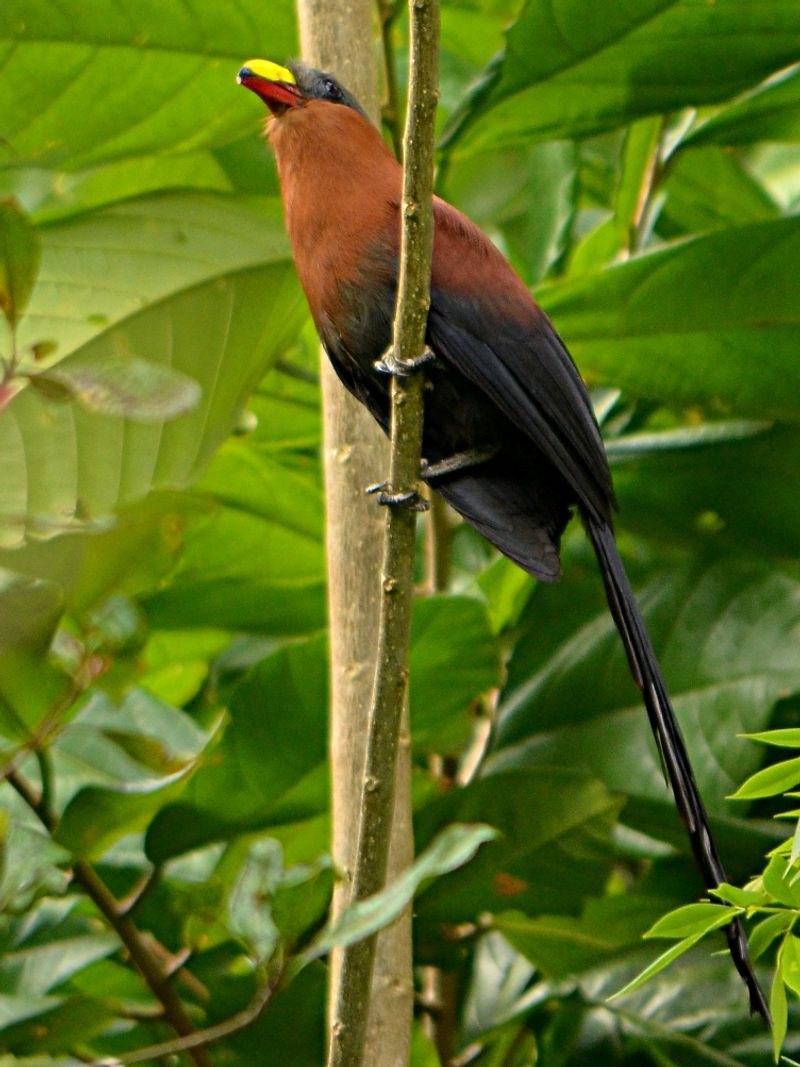
The yellow-billed malkoha is a bird that belongs to the Cuculidae family, which includes cuckoos. It can only be found in Sulawesi, Indonesia, where it inhabits subtropical or tropical moist lowland forests.
This bird has a unique yellow bill which makes it stand out from other species of cuckoo. Its habitat is characterized by moist forests with dense vegetation. The yellow-billed malkoha is a shy bird that lives in the canopy of the forest and is rarely seen in the open.
It feeds mainly on insects and other invertebrates, which it finds hidden among the foliage. This species of cuckoo is considered to be endangered because of habitat loss and hunting.
Conservation efforts have been made to protect this species, such as creating protected areas for its habitat and enforcing laws against hunting. With continued efforts, this species may be saved from extinction.
| Kingdom | Animalia |
| Phylum | Chordata |
| Class | Aves |
| Order | Cuculiformes |
| Family | Cuculidae |
| Genus | Rhamphococcyx |
| Species | R. calyorhynchus |
3. Red-Backed Thrush
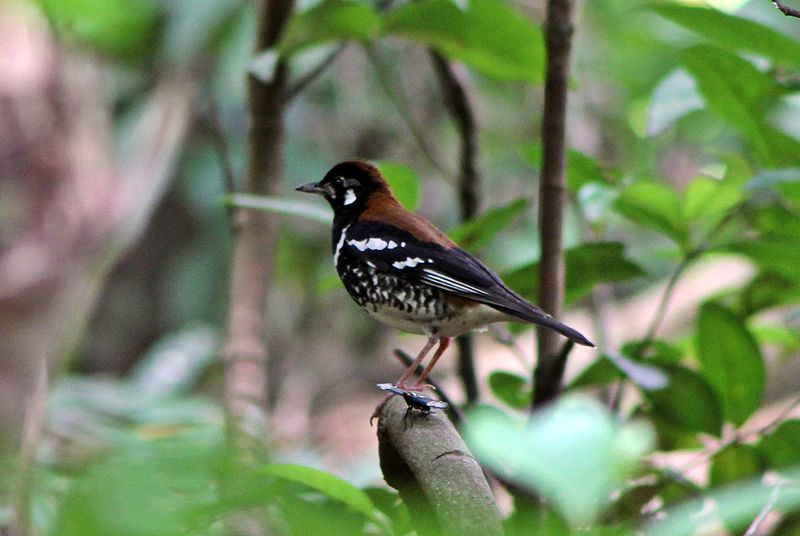
The red-backed thrush is a species of bird belonging to the family Turdidae, which is native to forests on Sulawesi, Buton, and Kabaena in Indonesia. It is known for its reddish-brown back and black wings and tail.
Traditionally, it has been classified as including the red-and-black thrush as a subspecies. Unfortunately, this species is becoming increasingly rare due to habitat destruction.
The loss of its native habitat is a result of human activities such as logging, mining, and agricultural expansion. This has had a devastating effect on the bird, as its population has been steadily declining.
It is estimated that there are only a few thousand individuals remaining in the wild. In order to prevent the further decline of the red-backed thrush, conservation efforts must be employed.
This includes protecting its habitat from destruction, as well as introducing laws and regulations that can be used to limit human activities in the area. In addition, more research needs to be done to better understand the species and its needs.
It is essential that steps are taken to ensure the survival of the red-backed thrush, as its loss would be a tragedy for the species and its environment. Without proper conservation efforts, this species could become extinct in the near future.
| Kingdom | Animalia |
| Phylum | Chordata |
| Class | Aves |
| Order | Passeriformes |
| Family | Turdidae |
| Genus | Geokichla |
| Species | G. erythronota |
4. Sulawesi Ground Dove
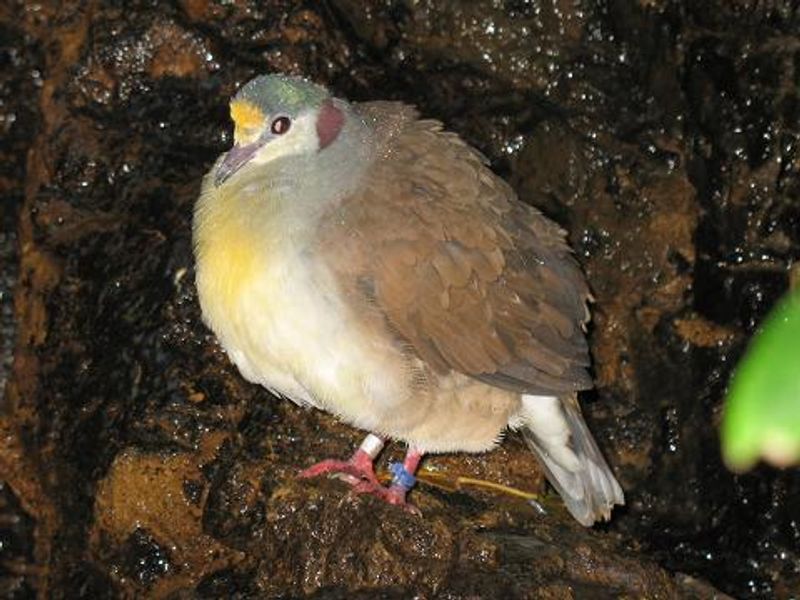
The Sulawesi Ground-Dove is a species of medium-sized bird native to Sulawesi, Indonesia. It is characterized by its olive-brown coloration, with a golden forehead and yellow breast, and a vibrant blue-green crown.
The head of the dove is capped off with a purple patch behind the ear coverts, and the tail is dark brown with white undersides. Both male and female Sulawesi Ground Doves look very similar, with no major differences in their physical appearance.
The Sulawesi Ground Dove is about 35 cm in length and is a ground-dwelling species, preferring to remain on the ground rather than fly high in the air.
The species has an iridescent blue-green crown which is quite eye-catching and noticeable, with a purple patch behind the ear coverts. It also has a golden forehead, yellow breast, red legs, and dark brown tail. The underside of the dove is white.
The Sulawesi Ground-Dove is a species that is threatened by habitat destruction, hunting, and trapping. It is currently classified as near threatened by the IUCN, and conservation efforts are being made to protect the species and its dwindling population.
| Kingdom | Animalia |
| Phylum | Chordata |
| Class | Aves |
| Order | Columbiformes |
| Family | Columbidae |
| Genus | Gallicolumba |
| Species | G. tristigmata |
5. Sulawesi Nightjar
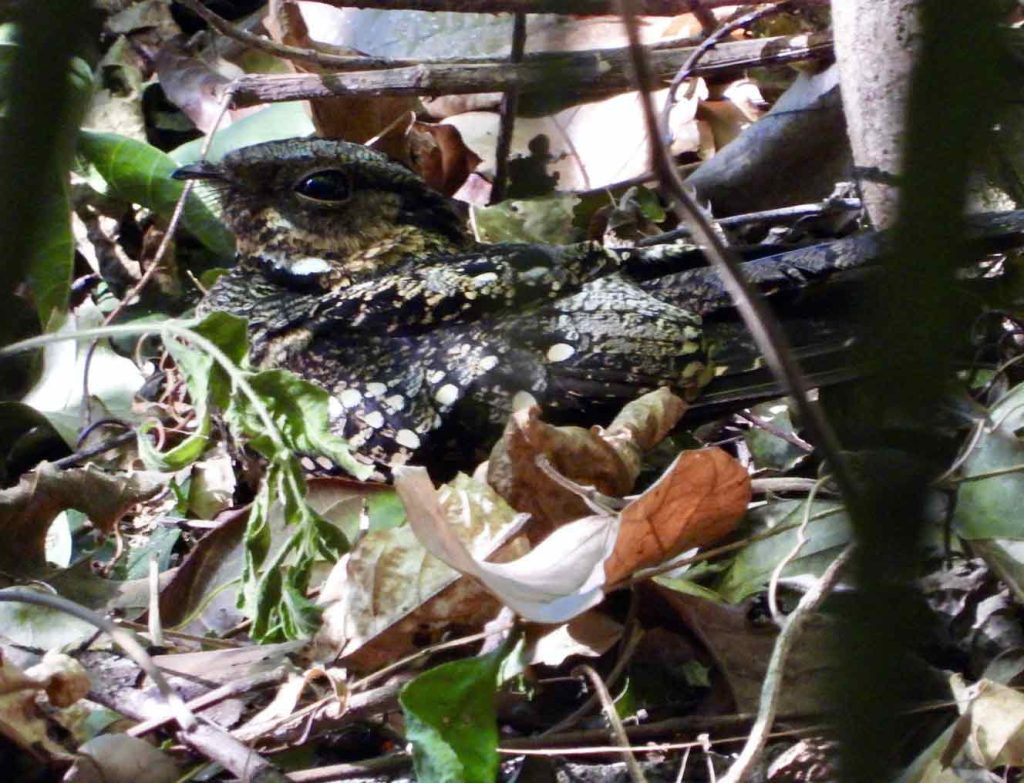
Source: ebird.org
The Sulawesi nightjar is a species of nightjar that belongs to the family Caprimulgidae, which also includes other species of nightjars. It is native to Indonesia, where it is found on Sulawesi and the Sula Islands.
It can be found living in two different kinds of habitats: subtropical or tropical moist lowland forests, and subtropical or tropical mangrove forests. These birds prefer forested habitats, and they can often be found near bodies of water, where they hunt for insects at night.
The Sulawesi nightjar can be recognized by its dark brown plumage, which is speckled with white spots. It has a long, rounded tail, and its wings are short and rounded.
The nightjar is a nocturnal bird, and it spends most of its time roosting during the day, usually on branches high up in the trees. It is an important species in the ecosystem, as it helps to keep insect populations in check.
| Kingdom | Animalia |
| Phylum | Chordata |
| Class | Aves |
| Clade | Strisores |
| Order | Caprimulgiformes |
| Family | Caprimulgidae |
| Genus | Caprimulgus |
| Species | C. celebensis |
6. Black-Billed Koel
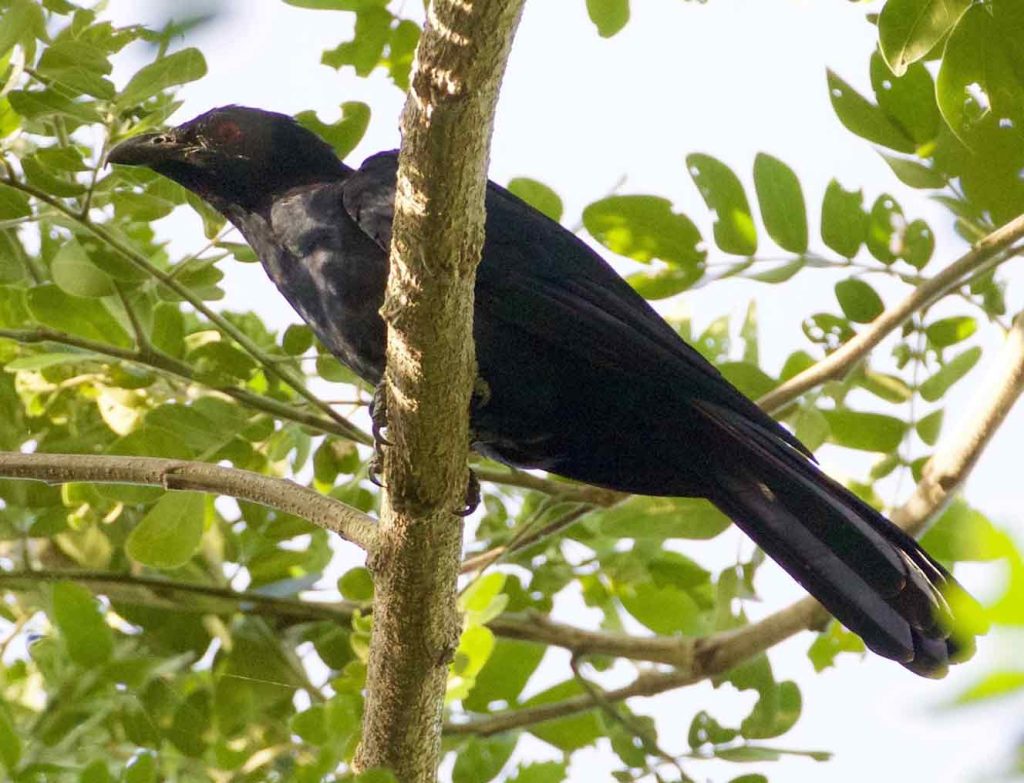
Source: ebird.org
The black-billed koel (Eudynamys scolopaceus) is a species of cuckoo in the family Cuculidae, which is native to the Indonesian islands of Sulawesi, Sula, Banggai, Togian, and other smaller nearby islands. It is usually found in forest and woodland habitats.
The species was formerly considered to be the same as E. scolopaceus, but recent studies have shown that they are distinct species. The black-billed koel is a medium-sized bird, with a black bill, dark plumage, and white eyes.
It has a distinctive call that is a repeated “know” or “kaoo”. The species feeds mainly on insects and fruits.
It is solitary in nature and usually found perched on a branch in the forest. The black-billed koel is considered to be of least concern by the International Union for Conservation of Nature (IUCN).
This is due to its large range and population size, which is thought to be stable. However, habitat destruction and fragmentation may pose a threat to its survival in the future.
| Kingdom | Animalia |
| Phylum | Chordata |
| Class | Aves |
| Order | Cuculiformes |
| Family | Cuculidae |
| Genus | Eudynamys |
| Species | E. melanorhynchus |
7. Pink-Necked Green Pigeon
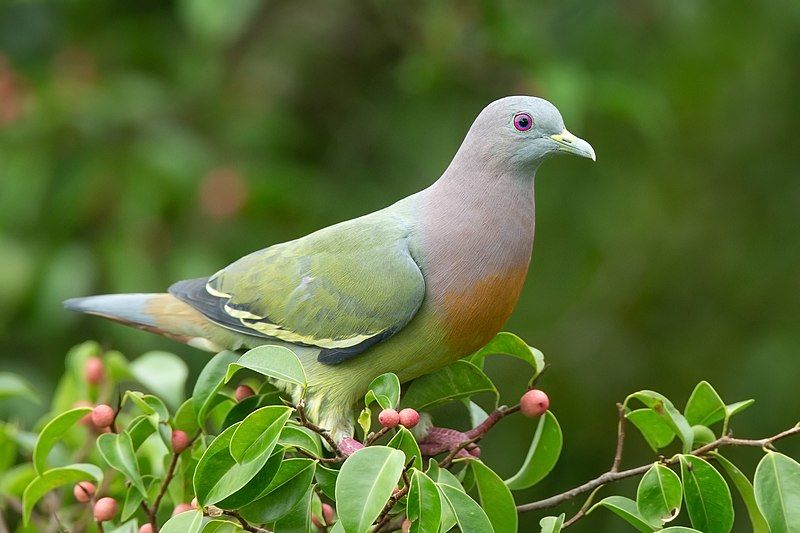
The pink-necked green pigeon is a species of bird that belongs to the Columbidae family, which also includes pigeons and doves.
This species is native to Southeast Asia, with its range extending from Myanmar and Vietnam through to the major islands of Indonesia and the Philippines. It is a common species in these areas and is often seen in parks, gardens, and woodlands.
It is easily distinguished from other species of pigeon by its bright green plumage and pink neck. The pink-necked green pigeon is usually found in small groups and feeds mainly on fruits, seeds, and insects.
It nests in trees, often in colonies, and lays two to three eggs per clutch. It can be quite vocal, with males producing a loud cooing call. This species is an important member of its local ecosystems, providing food for other animals and dispersing the seeds of various plants.
| Kingdom | Animalia |
| Phylum | Chordata |
| Class | Aves |
| Order | Columbiformes |
| Family | Columbidae |
| Genus | Treron |
| Species | T. vernans |
8. Green Imperial Pigeon
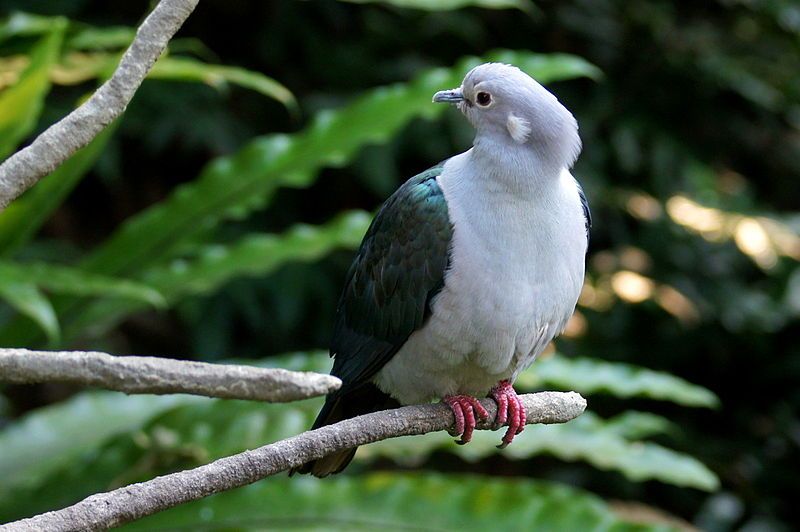
The green imperial pigeon is a large bird found in many parts of Asia. It has a wide range, stretching from Nepal in the west, through southern India and Sri Lanka, all the way east to southern China, Indonesia, and the Philippines.
It is generally found in forested areas, making its home in the thick foliage of trees. It is a relatively large pigeon, measuring up to 40 cm in length and weighing up to 600 g.
It has an impressive wingspan of up to 75 cm and is easily recognizable by its bright green and purple plumage. It generally feeds on seeds, fruits, and berries, and may even feed on small invertebrates.
It is an important species for many local communities in its range, providing a source of food and income. It is also an important species for its role in maintaining the health of its habitat, as it disperses seeds while foraging.
| Kingdom | Animalia |
| Phylum | Chordata |
| Class | Aves |
| Order | Columbiformes |
| Family | Columbidae |
| Genus | Ducula |
| Species | D. aenea |
9. Black-Naped Fruit Dove
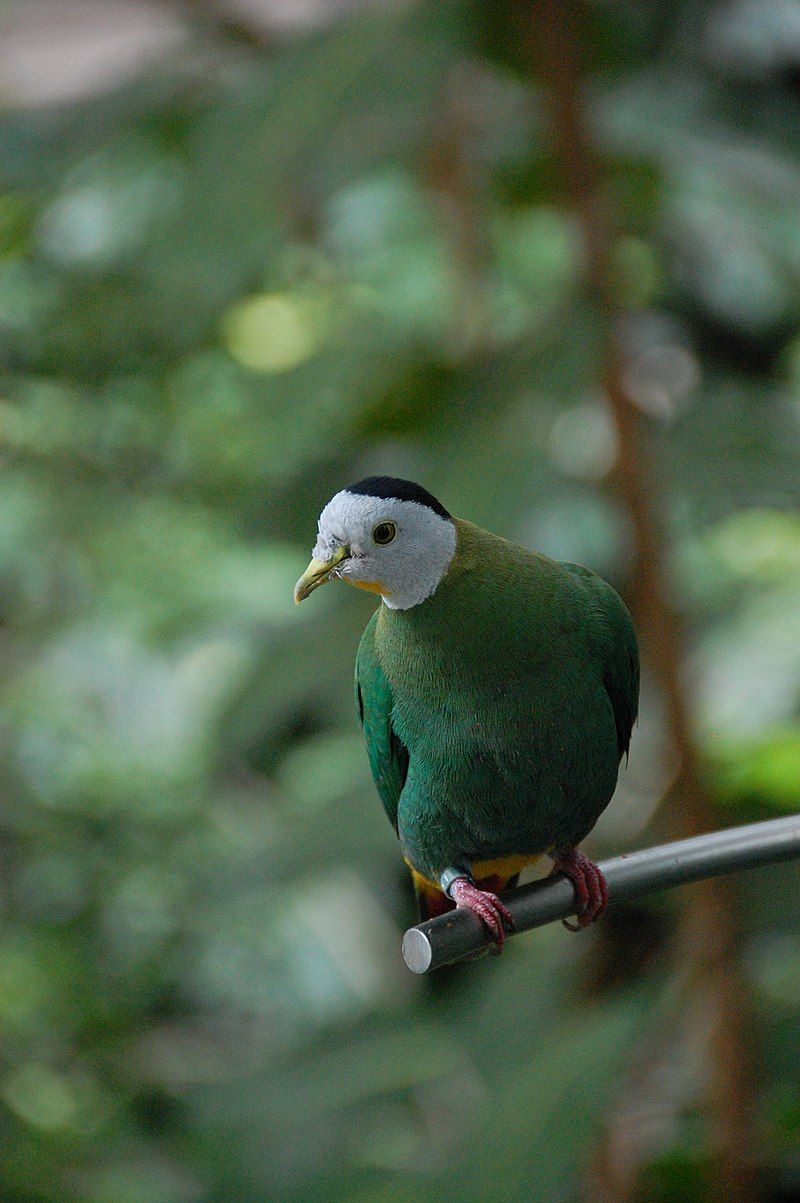
The black-naped fruit dove is a striking bird with an impressive array of colors. It is a medium-sized dove, measuring up to 24 cm in length, with a green body, yellow bill, and brown iris.
The male black-naped fruit dove has a special appearance with a pale grey head, black nape, yellow throat, and golden yellow and pink under tail coverts. This color combination is quite unique and makes the bird stand out from other species.
The black-napped fruit dove is also known as the black-headed fruit dove because of the distinctive black nape that the male has. The black-naped fruit dove is found in open forests and woodlands in Southeast Asia and the Pacific Islands.
It feeds mainly on fruits and flowers, as well as some insects and other invertebrates. It has a melodious call and is often seen in pairs or small flocks. The black-naped fruit dove is a beautiful bird that is a delight to see in the wild.
Its striking plumage and melodious call make it a popular species with birdwatchers.
| Kingdom | Animalia |
| Phylum | Chordata |
| Class | Aves |
| Order | Columbiformes |
| Family | Columbidae |
| Genus | Ptilinopus |
| Species | P. melanospilus |
10. Isabelline Bush-Hen
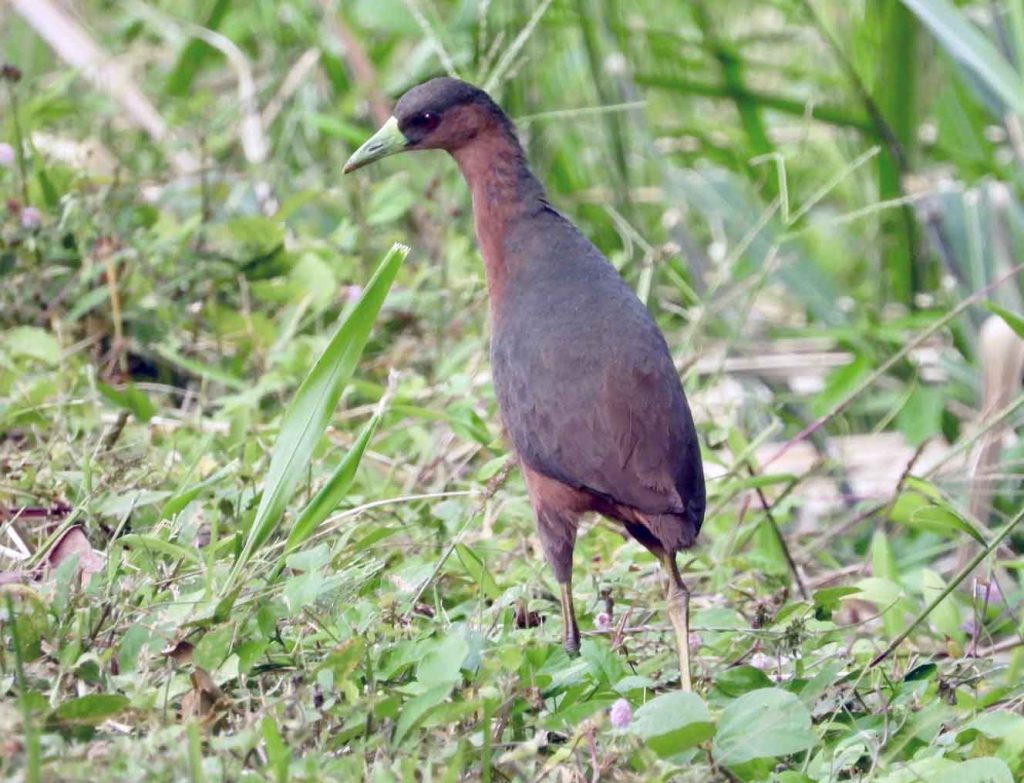
Source: ebird.org
The isabelline bush-hen is a large species of rail that can be found in Sulawesi. It can grow up to 40 cm long and has a rufous and brown coloration. This coloration gives the bird its name, as isabelline is a shade of light brownish-gray.
It is the biggest species in its genus, Amaurornis, making it easily distinguishable from other species. The isabelline bush-hen is found near wetland areas, such as marshes, swamps, and shallow streams, where it hunts for food such as insects, worms, and small fish.
The bird is shy and secretive, so it is not often seen out in the open. When it is out in the open, it uses its camouflage coloration to blend in with the vegetation. The isabelline bush-hen is an important part of the Sulawesi ecosystem.
It helps to keep insect populations in check, which in turn benefits the other animals and plants in the area.
The bird is also an important food source for other animals, such as snakes and raptors. The isabelline bush-hen is an interesting species that plays an important role in its environment. It is important to protect the bird’s habitat in order to ensure its continued survival.
| Kingdom | Animalia |
| Phylum | Chordata |
| Class | Aves |
| Order | Gruiformes |
| Family | Rallidae |
| Genus | Amaurornis |
| Species | A. isabellina |
11. Cinnabar Boobook
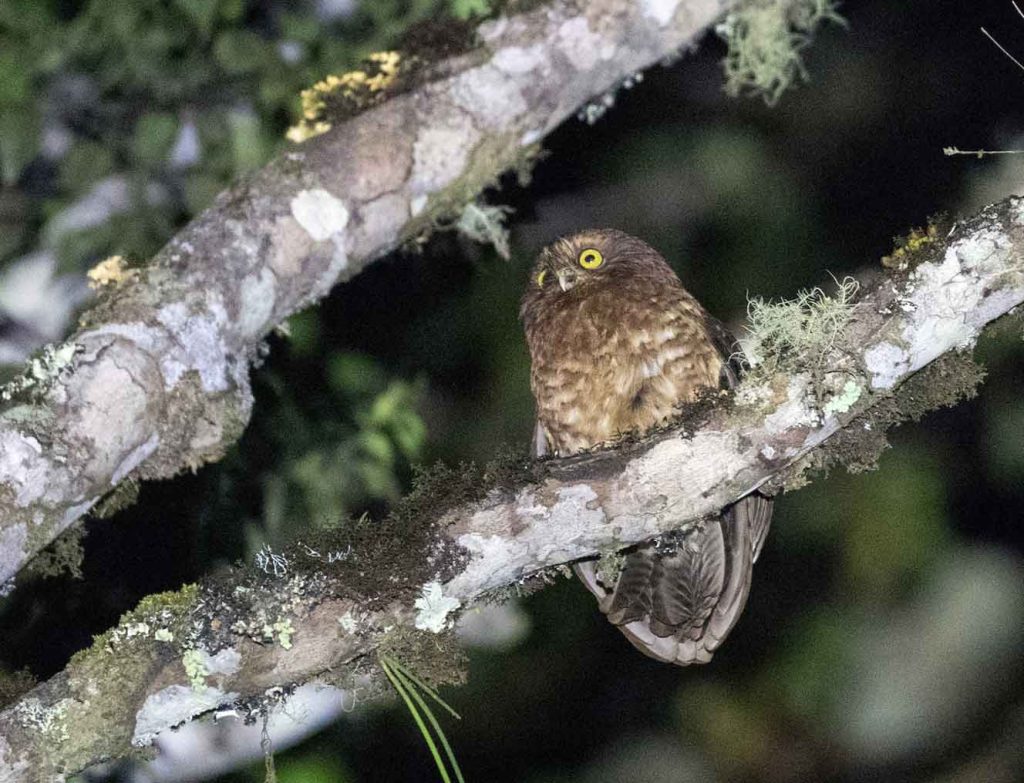
Source: ebird.org
The cinnabar boobook is a species of hawk owl that is only found on the Indonesian island of Sulawesi. It is a small, nocturnal owl that is easily identifiable by its distinctive reddish-brown coloration, which has earned it the alternate name of cinnabar hawk-owl.
This species of bird is highly specialized for hunting in the dark and is equipped with excellent vision and hearing to aid in its nocturnal lifestyle. Its diet consists mainly of small mammals, insects, and other small invertebrates.
It is a vocal species, with a variety of hoots and whistles that it uses to communicate with other members of the same species.
As an endemic species, the cinnabar boobook is especially vulnerable to changes in its environment, making it important to protect its habitat in order to ensure its survival.
| Kingdom | Animalia |
| Phylum | Chordata |
| Class | Aves |
| Order | Strigiformes |
| Family | Strigidae |
| Genus | Ninox |
| Species | N. ios |
12. Pied Imperial Pigeon
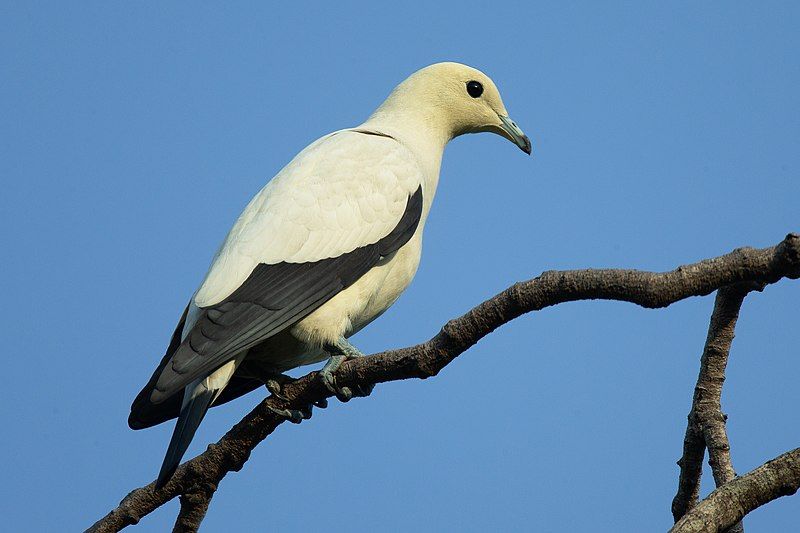
The pied imperial pigeon is an impressive bird species. It has a unique pied pattern of black, white, and grey feathers, and is larger than most other pigeon species. This species is native to Southeast Asia, where it can be found in a variety of habitats.
It is most commonly observed in forests, woodland, mangrove, plantations, and scrub. Its range extends from Myanmar and Thailand in the west across Indonesia and as far east as the Philippines and the Bird’s Head Peninsula in New Guinea.
It has been recorded on a variety of islands in this region, including Borneo, Sumatra, and Sulawesi. Imperial pigeons are popular with birdwatchers, as they are generally easy to spot thanks to their large size and distinctive plumage.
They are also an important food source for many local communities across their range.
| Kingdom | Animalia |
| Phylum | Chordata |
| Class | Aves |
| Order | Columbiformes |
| Family | Columbidae |
| Genus | Ducula |
| Species | D. bicolor |
13. Channel-billed Cuckoo
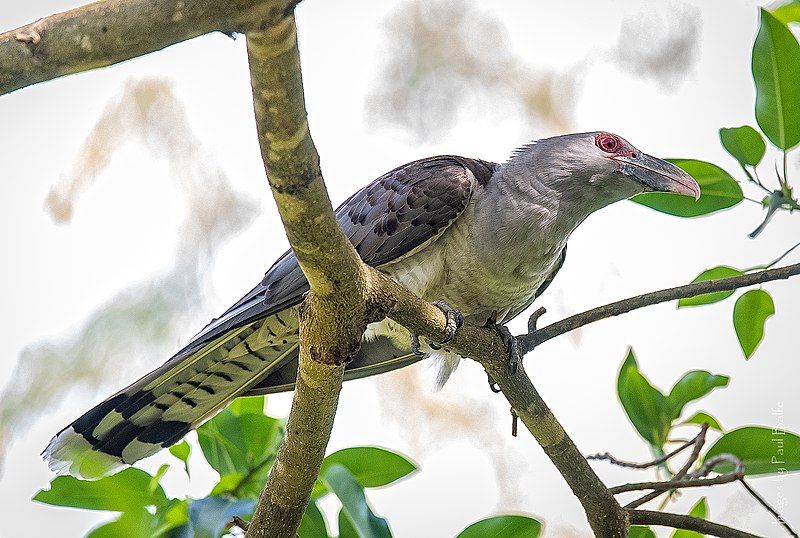
The channel-billed cuckoo is an impressive bird that is found in Australia, New Guinea, Indonesia, New Caledonia, and New Zealand. It is the only species in the genus Scythrops and is the largest of the cuckoo family, Cuculidae.
This species is the largest brood parasite in the world, meaning that it lays its eggs in the nest of another bird species so that it will raise its young. The cuckoo parents may not even stay to watch their offspring develop.
This behavior gives the cuckoo an advantage in the wild, as it does not have to spend its energy rearing its young.
The channel-billed cuckoo is considered a vagrant in New Caledonia and New Zealand, meaning that it usually is not a permanent resident there, but rather only visits these areas from time to time.
| Kingdom | Animalia |
| Phylum | Chordata |
| Class | Aves |
| Order | Cuculiformes |
| Family | Cuculidae |
| Genus | Scythrops |
| Species | S. novaehollandiae |
14. Superb Fruit Dove
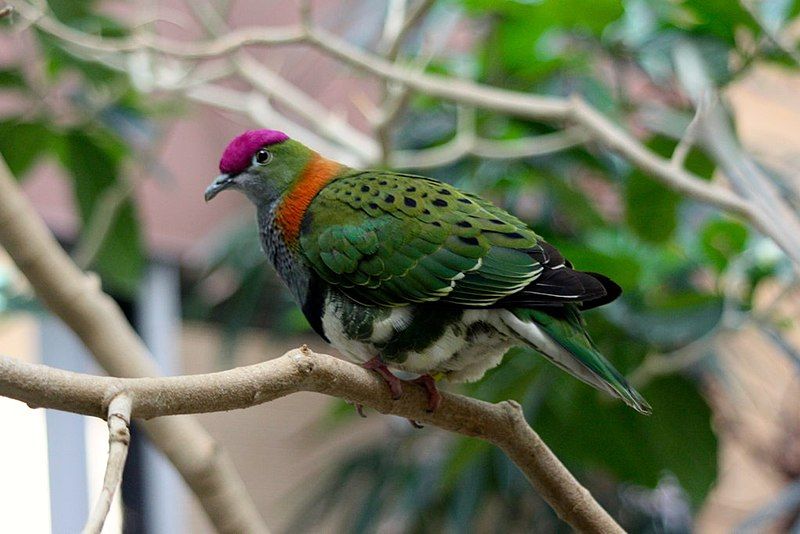
The superb fruit dove is a type of bird belonging to the Columbidae family. It is a medium-sized bird with an eye-catching array of colorful feathers. Its most prominent feature is its purple-crowned head, a striking addition to its already vibrant plumage.
The superb fruit dove is also known as the purple-crowned fruit dove, due to its distinct purple-colored crown. This species of bird is mainly found in the tropical regions of the Pacific Islands, including the Solomon Islands, New Guinea, and the Philippines.
Its diet consists mainly of fruits, hence its name, which it can find in abundance in its habitat. As with many other species of birds, the superb fruit dove is an important part of the local ecosystem, helping to disperse seeds from the fruits it consumes.
This species of dove is also a beloved sight in many gardens, where it’s vibrant colors and melodious call bring a sense of peace and joy to any outdoor setting.
| Kingdom | Animalia |
| Phylum | Chordata |
| Class | Aves |
| Order | Columbiformes |
| Family | Columbidae |
| Genus | Ptilinopus |
| Species | P. superbus |
15. Red-collared dove
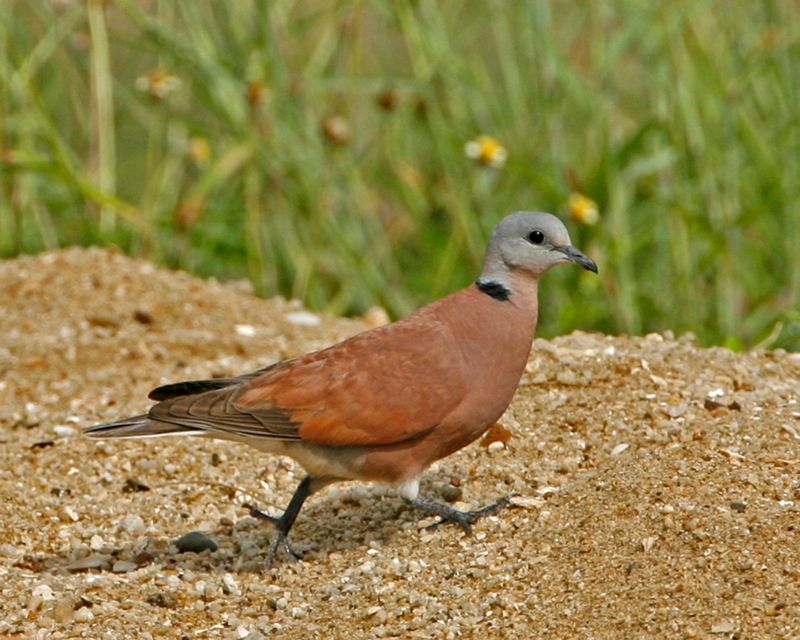
The red-collared dove, also known as the red turtle dove, is a small species of pigeon that is native to the tropical regions of Asia.
It is easily identified by its distinct coloration; the male has a blue-grey head and a red-brown body, while the female has pale brown plumage that closely resembles that of the larger Eurasian collared dove.
The red-collared dove is a resident breeding bird, meaning it does not migrate and instead chooses to stay in its native region, establishing home territories and mating patterns. The dove is a common sight in the tropics of Asia, and it is often seen in parks and gardens.
It feeds on a variety of grains, seeds, fruits, and invertebrates. The red-collared dove is generally a peaceful bird, but during the breeding season, it can become quite aggressive, and may even attack other birds that come too close to its nest.
| Kingdom | Animalia |
| Phylum | Chordata |
| Class | Aves |
| Order | Columbiformes |
| Family | Columbidae |
| Genus | Streptopelia |
| Species | S. tranquebarica |
16. Hemiprocne longipennis
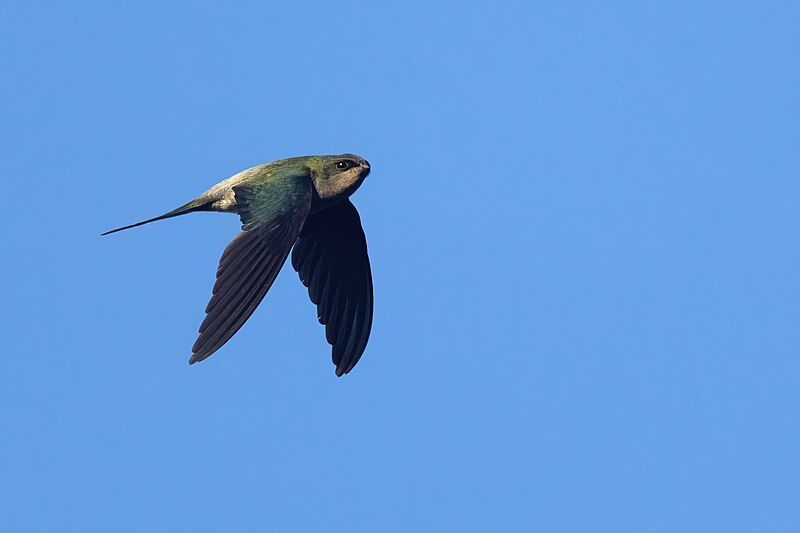
The grey-rumped treeswift is a species of bird belonging to the Hemiprocnidae family. The Hemiprocnidae family consists of tree swifts and is one of the two extant families in the Apodiformes order.
There are currently four species in the Hemiprocnidae family, all of which are placed in the same genus, Hemiprocne. These species are distributed across tropical and subtropical Asia and Africa. The grey-rumped treeswift is a medium-sized swift, growing up to 24 cm in length.
These birds have a distinctive grey rump and a long, forked tail. Additionally, they have a wingspan of 42-45 cm, making them one of the larger species of swifts.
Their plumage is mostly grey, with a white throat and black and white stripes on the wings. The grey-rumped treeswift is a highly aerial species and is often seen gliding and swooping in the sky. These birds feed mainly on insects, which they catch on the wing.
They are also known to sometimes feed on small lizards, frogs, and other small animals. The grey-rumped treeswift typically breeds in tropical and subtropical areas. They build a cup-shaped nest out of twigs, leaves, and grasses, and line it with feathers.
The female lays two to three eggs, and both parents take part in the incubation. The chicks fledge after about three weeks. Overall, the grey-rumped treeswift is a fascinating species of bird. It is a highly aerial species that is adapted for catching insects on the wing.
Its unique plumage and behavior make it a welcome sight in many tropical and subtropical areas.
| Kingdom | Animalia |
| Phylum | Chordata |
| Class | Aves |
| Clade | Strisores |
| Order | Apodiformes |
| Family | Hemiprocnidae |
| Genus | Hemiprocne |
| Species | H. longipennis |
17. Black-Backed Swamphen
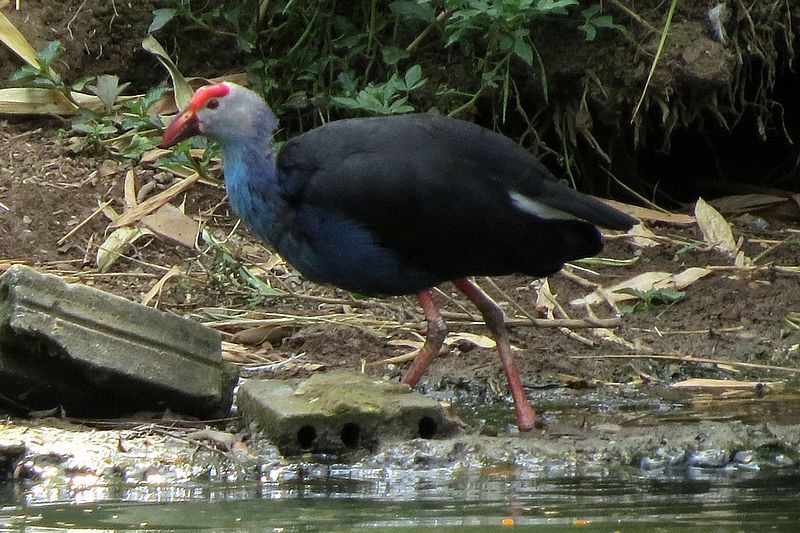
The black-backed swamphen is a distinct species of swamphen that is native to Southeast Asia, Sulawesi, and Borneo. It is similar in appearance to the purple swamphen but is distinguished by its large shield, black upperparts, and blackish side of the head.
This species is often found in wetlands, such as marshes and swamps, and feeds in shallow water on plants, invertebrates, and other aquatic organisms. The black-backed swamphen has a wide range and is able to survive in a variety of habitats.
It is also quite adaptable and can be found in areas with human disturbance, such as agricultural areas, and in urban areas.
It is considered to be a relatively common species, but its population size is thought to be declining due to habitat destruction and other human-induced activities. The black-backed swamphen has a strong parental bond, and pairs typically remain together for life.
The female builds a nest in vegetation near the water, and both parents help to incubate the eggs and care for the chicks. The chicks are able to feed themselves, but the parents continue to care for them until they are ready to leave the nest.
Overall, the black-backed swamphen is a fascinating species that is adapted to a wide range of habitats. It is an important part of the wetland ecosystem, and its future should be protected.
| Kingdom | Animalia |
| Phylum | Chordata |
| Class | Aves |
| Order | Gruiformes |
| Family | Rallidae |
| Genus | Porphyrio |
| Species | P. indicus |
18. Silver-tipped imperial pigeon
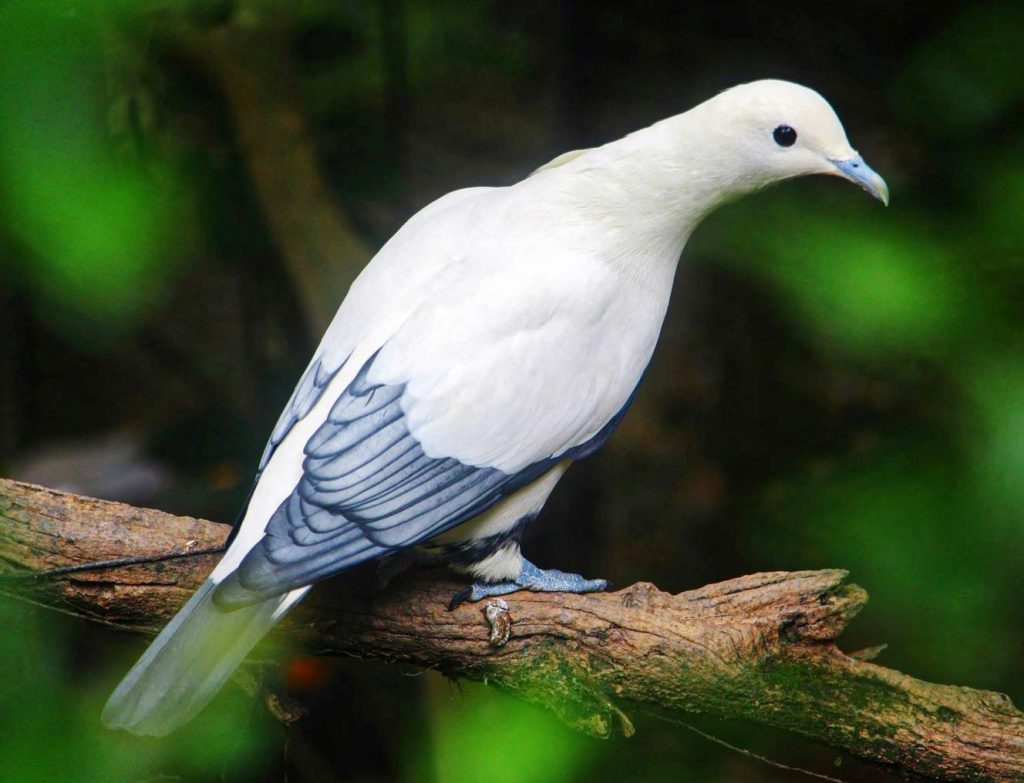
Source: zoochat.com
The Silver-tipped Imperial Pigeon is an impressive and eye-catching bird, belonging to the family Columbidae. It is mainly found in the forests, woodlands, and mangrove habitats of Sulawesi and the smaller islands around it.
The bird is easily recognizable by its silver-tipped feathers, which gives it its unique name.
It is a relatively large species of bird, typically growing to a length of between 30 and 35 cm. The Silver-tipped Imperial Pigeon is typically found in lowland forests and woodlands, and they also inhabit mangroves.
It feeds on fruits and berries which are found in these habitats. They are typically found in pairs or small groups, and they are also known to congregate in large flocks at fruiting trees.
These birds are mainly arboreal and rarely come to the ground. The Silver-tipped Imperial Pigeon is considered to be of least concern for conservation status due to its wide distribution and its abundant numbers.
However, the bird is still threatened by habitat loss and degradation, and by hunting for food. In order to ensure the survival of this species, conservation efforts need to be made to protect its habitat and to regulate hunting.
| Kingdom | Animalia |
| Phylum | Chordata |
| Class | Aves |
| Order | Columbiformes |
| Family | Columbidae |
| Genus | Ducula |
| Species | D. luctuosa |
19. Sulawesi Cuckoo
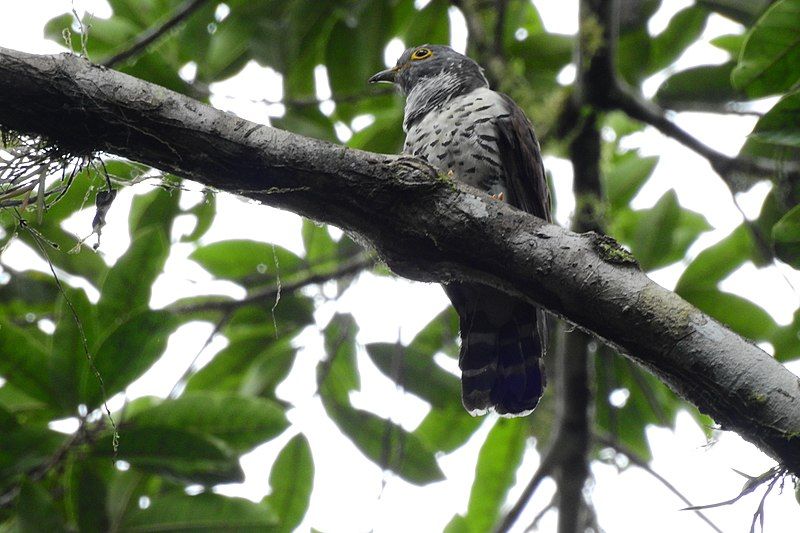
The Sulawesi cuckoo is an interesting bird species that can be found only on Sulawesi Island in Indonesia. It is a species of cuckoo that belongs to the family Cuculidae and is commonly known as the Sulawesi hawk-cuckoo.
However, it is important to note that this bird is not related to the other hawk cuckoos. The Sulawesi cuckoo is typically found in subtropical and tropical moist montane forests. This type of environment is characterized by a temperate climate and abundant vegetation.
The cuckoos find plenty of food and shelter in these moist montane forests. They also typically nest in trees and bushes, which helps to keep them protected from predators. The Sulawesi cuckoo is an important species to the environment of Sulawesi Island.
It helps to maintain the ecological balance by controlling the population of certain insects and other small animals. It also provides beauty and interest to the island’s landscape. Unfortunately, this species is threatened by deforestation and hunting.
As Sulawesi Island’s forests are being cleared for agriculture and timber production, the Sulawesi cuckoo is losing its natural habitat and is becoming increasingly rare. Additionally, the bird is often hunted for food, which further reduces its population.
It is important to protect this species and its habitat in order to ensure its survival. Efforts should be made to raise awareness about the threats facing the Sulawesi cuckoo, as well as to create conservation initiatives that will help to preserve its natural habitat.
By doing so, we can ensure that this unique species remains part of Sulawesi Island’s rich biodiversity for years to come.
| Kingdom | Animalia |
| Phylum | Chordata |
| Class | Aves |
| Order | Cuculiformes |
| Family | Cuculidae |
| Genus | Cuculus |
| Species | C. crassirostris |
20. Glossy swiftlet
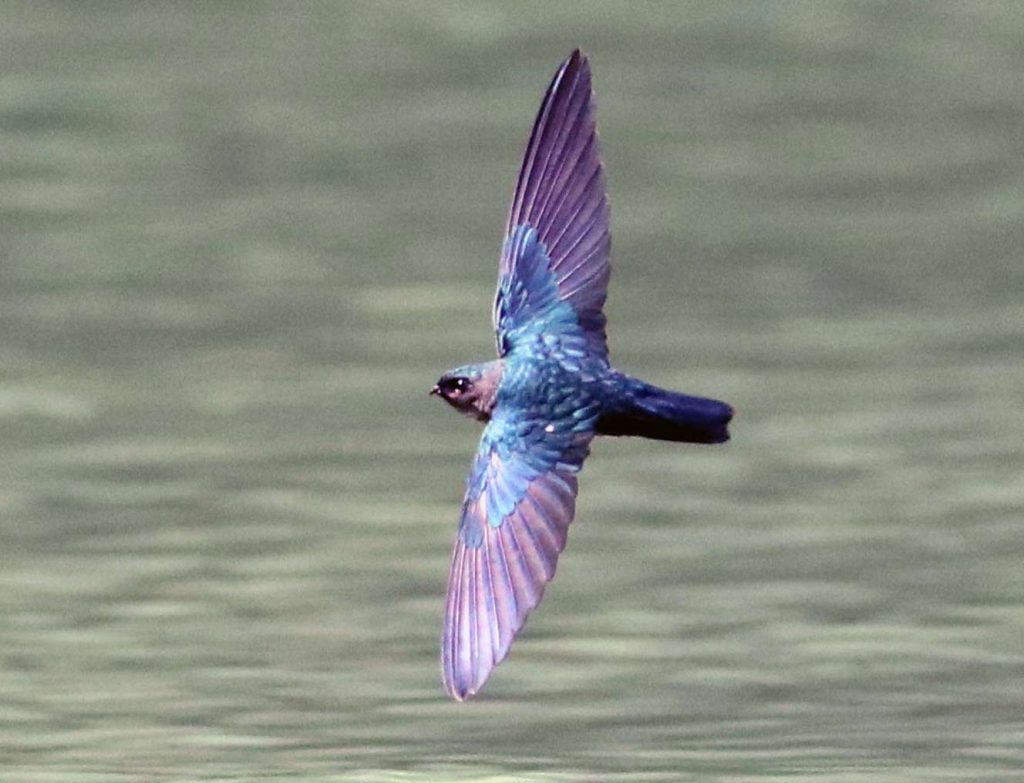
Source: ebird.org
The glossy swiftlet (Aerodramus esculenta) is a species of swift found in parts of Southeast Asia, including the Indonesian island of Sulawesi and eastwards to New Guinea, the Bismarck Archipelago, and the Solomon Islands.
It is a member of the family Apodidae, which includes swifts, hummingbirds, and treeswifts. The glossy swiftlet is a small bird with a glossy black head and back. Its underparts are white, except for the lower belly, which is brownish-gray.
The wings and tail are black with white edges. Its bill is black, and its legs are gray.
The glossy swiftlet is usually found in forest and woodland habitats, nesting in hollows in trees or in rock crevices.The glossy swiftlet is an insectivorous species, feeding mainly on flying insects. During the breeding season, they may also feed on fruit.
They use their wings to catch insects in mid-air and then swallow them whole. The glossy swiftlet is a social species, often seen in large flocks. They are vocal birds, making chirping and chattering noises in flight.
They are also known to produce loud, twittering calls when flying. The glossy swiftlet is a migratory species, undertaking seasonal movements between its breeding grounds and wintering grounds.
During the breeding season, they form large colonies in tree cavities or cliff crevices. The female lays two white eggs in a nest of feathers and down. Both parents feed the young.
| Kingdom | Animalia |
| Phylum | Chordata |
| Class | Aves |
| Clade | Strisores |
| Order | Apodiformes |
| Family | Apodidae |
| Genus | Collocalia |
| Species | C. esculenta |
21. Little Bronze Cuckoo
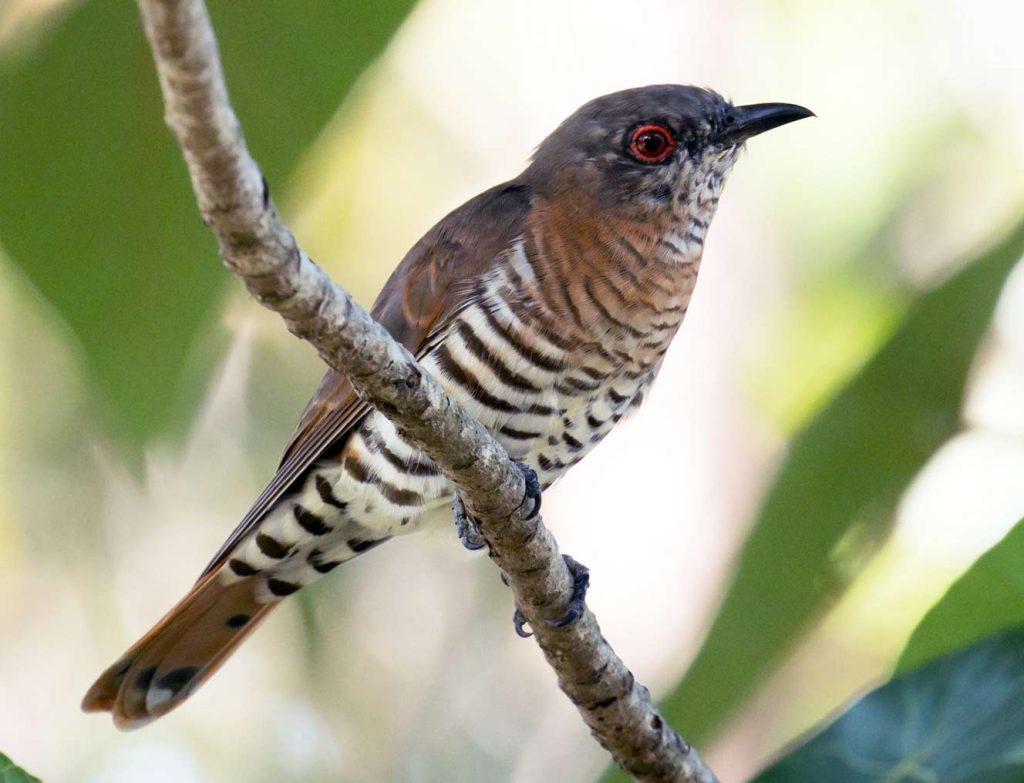
Source: ebird.org
The Little Bronze-Cuckoo is a type of bird belonging to the family Cuculidae. This species of cuckoo is native to Southeast Asia, New Guinea, and northern and eastern Australia, where it lives in subtropical or tropical moist lowland forests.
It is the smallest of all cuckoo species, measuring just 15 cm in length and weighing only 17 grams. This makes it one of the world’s tiniest birds. The Little Bronze-Cuckoo is mainly a solitary bird but may form small flocks during the breeding season.
Its diet consists of insects, spiders, and worms and it usually forages for food on the ground. During the breeding season, the female lays her eggs in the nest of another bird species, usually a small passerine, such as a finch or warbler.
The young Little Bronze Cuckoo is then raised by the foster parents, although the male will sometimes provide food to the young cuckoo as well.
| Kingdom | Animalia |
| Phylum | Chordata |
| Class | Aves |
| Order | Cuculiformes |
| Family | Cuculidae |
| Genus | Chrysococcyx |
| Species | C. minutillus |
22. Stephan’s Dove
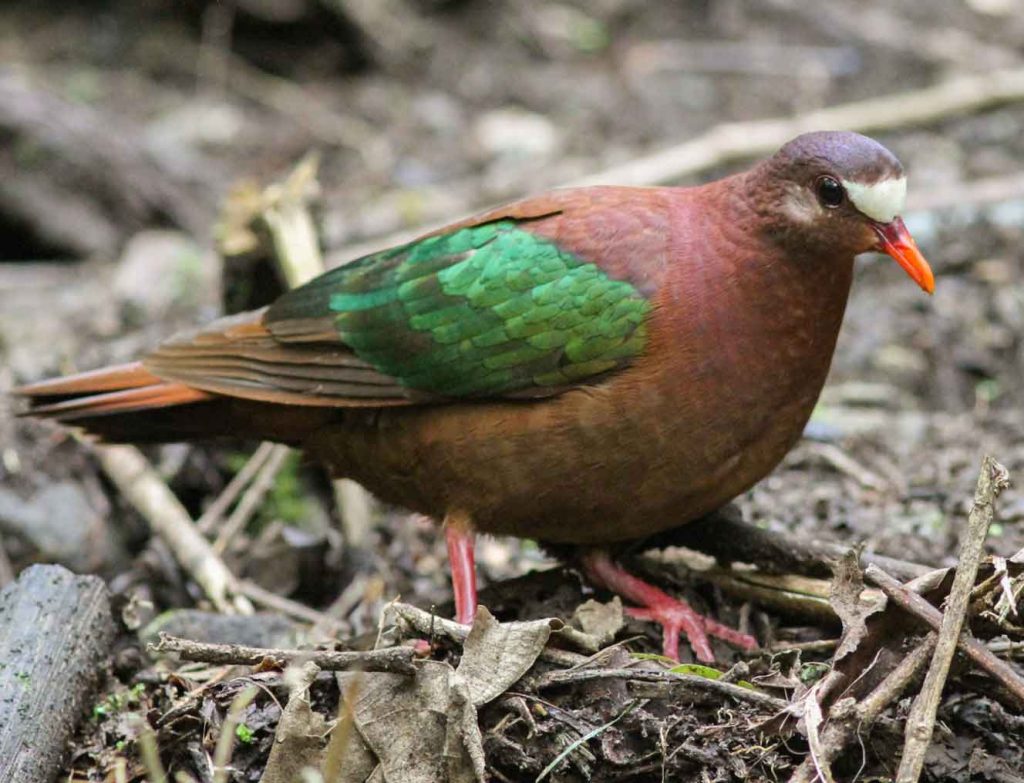
Source: ebird.org
Stephan’s dove is a species of bird that belongs to the Columbidae family. It is native to the islands of Sulawesi, New Guinea, and the Solomon Islands. This species is characterized by its emerald green color, which is why it is sometimes referred to as Stephan’s emerald dove.
The dove has a large head and short legs, with a long tail and wings. It has a grayish-brown back and wings, and white-tipped feathers on the wings and tail. This species feeds on a variety of seeds, fruits, and insects.
They usually nest on low branches or in trees, where they will make a shallow cup-shaped nest of twigs, grass, and leaves. They are usually found in small groups, but can sometimes be seen alone. They are quite vocal, making a variety of soft calls during the day.
Stephan’s dove is listed as a species of least concern by the International Union for Conservation of Nature. This species is not currently threatened, and its population is stable.
While there is some habitat loss due to deforestation, it does not appear to have had a significant impact on the population. As a result, Stephan’s dove is a common sight on the islands where it is found.
| Kingdom | Animalia |
| Phylum | Chordata |
| Class | Aves |
| Order | Columbiformes |
| Family | Columbidae |
| Genus | Chalcophaps |
| Species | C. stephani |
23. Cinnamon-Bellied Imperial Pigeon
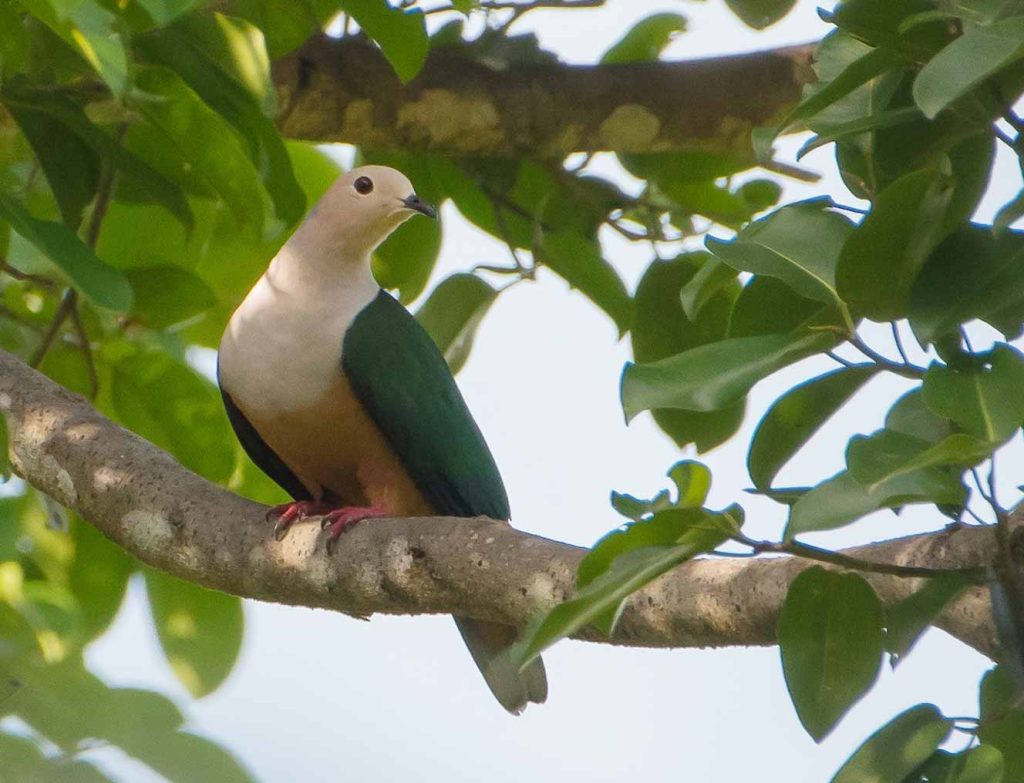
Source: ebird.org
The cinnamon-bellied imperial pigeon is a beautiful species of bird in the Columbidae family. It is found only in the northern Moluccas region, a group of islands in the eastern part of Indonesia.
Its natural habitat is the subtropical or tropical lowland forests that are moist and lush. These birds are large and can measure up to 40 cm in length. They have a brown head, a white neck, and a distinctive chest and belly that are a deep cinnamon color.
The wings are brown with white bars and the tail is black with white tips. The cinnamon-bellied imperial pigeon is a threatened species, due to the destruction of its natural habitat.
As a result, it is becoming increasingly rare and is now listed as endangered by the IUCN Red List. To help protect this species, conservation efforts need to be put in place to protect their habitats and ensure that their populations are not diminished any further.
| Kingdom | Animalia |
| Phylum | Chordata |
| Class | Aves |
| Order | Columbiformes |
| Family | Columbidae |
| Genus | Ducula |
| Species | D. basilica |
24. White-Breasted Waterhen
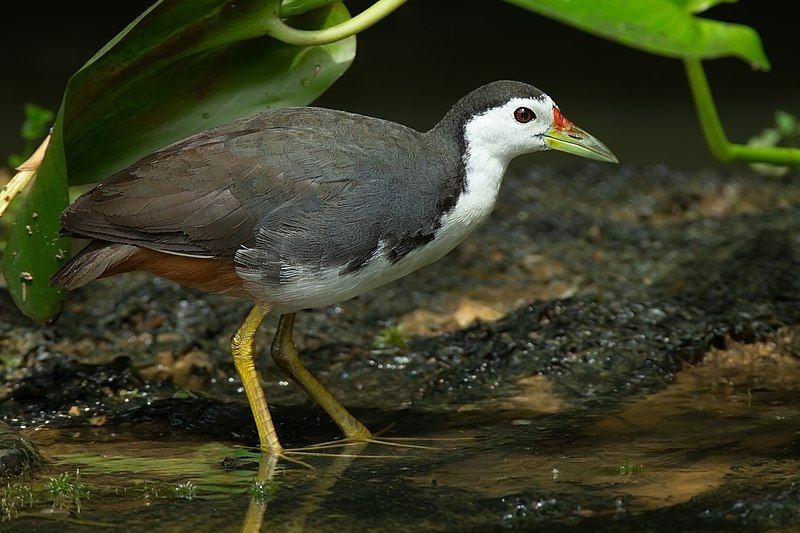
The white-breasted waterhen is an aquatic bird that is part of the Rallidae family, which is composed of rails and crakes. It is widely distributed throughout South and Southeast Asia, where it can be found in a variety of habitats.
The waterhen is characterized by its dark slaty color, with a distinct white facial area that extends to its breast and belly. It has a stout body with a short tail and a long bill, and its legs are short and stout with well-webbed feet.
Its wings are short and rounded, and its flight is strong and direct. White-breasted waterhens feed on aquatic plants, insects, and other invertebrates, and they also consume grains and fruits.
They are usually found in pairs or small groups, and they are highly adaptive and can survive in a variety of habitats. They are also quite vocal and can be heard throughout the day.
| Kingdom | Animalia |
| Phylum | Chordata |
| Class | Aves |
| Order | Gruiformes |
| Family | Rallidae |
| Genus | Amaurornis |
| Species | A. phoenicurus |
Conclusion
The birds of West Sulawesi are a diverse and fascinating group of species that are essential to the region’s ecology and economy.
They provide an important source of food for local communities and play an important role in maintaining the health of the local environment. The diversity of birds in West Sulawesi is a testament to the region’s unique biodiversity and its importance to the global environment.
With continued conservation efforts, the birds of West Sulawesi will continue to thrive in this unique part of the world.